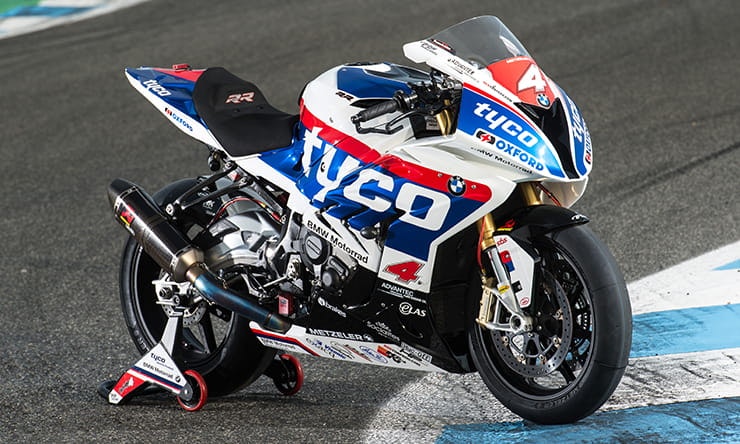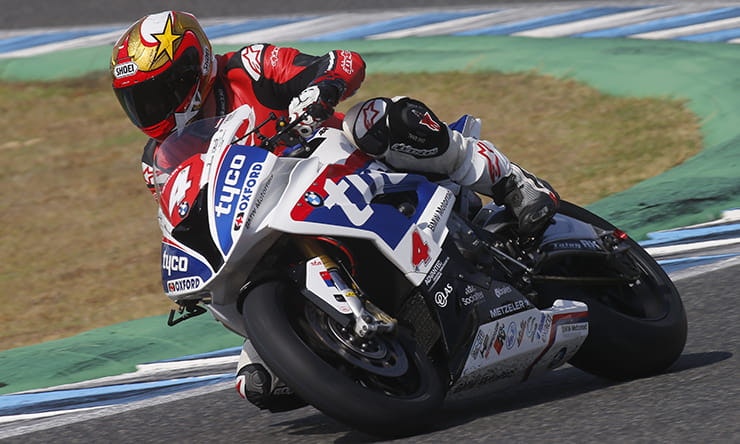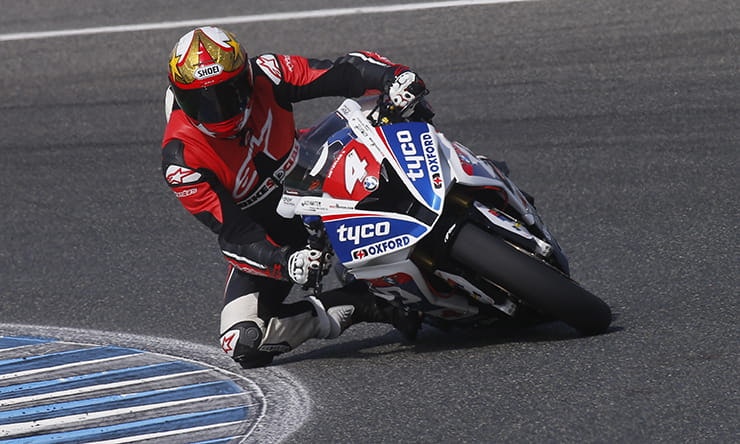With some 30% of BMW S1000RRs only ridden on the track, BMW is serious about making its flagship model one of the most successful race bikes on the planet.
With a TT-winning set-up that won all the big bike races at the 2016 TT with Michael Dunlop and Ian Hutchinson on-board, we jumped at the chance to ride Hutchy’s Superstock TT-winning Tyco BMW, and got a few laps on the Althea BMW factory World Superbike which has achieved a best of two fourth places in world superbikes. Serious bikes, with a serious message from BMW that they mean business in racing.
As part of BMW Motorrad’s Race Trophy, headed up by BMW race legend manager Berti Hauser, the firm offers support to BMW S1000RR riders in key championships worldwide.
This year to date, BMW says that the S1000RR has achieved 251 podiums and 85 race wins across 27 race classes worldwide, with some 127 riders on-board. That’s some success story. Not just that, but the BMW S1000RR is the fourth best-selling motorcycle in BMW’s line-up.
And with a set-up that means even club racers can email the factory for technical support, or download a new fuel map remotely via Wi-Fi on a race weekend, almost every single bit of data from these bikes goes into making the future S1000RR street bikes better for road riders.
In fact, if you had the right money you can even buy a world superbike engine (internal codename 7.2) from the BMW factory at some €23,000 plus tax, or a race-ready superstock engine built to the rules for around €17,000. That’s codename 5.2 if you need it.
But for now, let’s immerse ourselves in the gloriousness that is the chance to ride Ian Hutchinson’s TT-winning Tyco BMW superstock bike, followed by a few laps on Jordi Torres’ Althea BMW World Superbike race bike.
Superstock TT Tyco BMW S1000RR
This is the actual bike that Ian Hutchinson took to victory by 27-seconds at the Isle of Man Superstock TT race earlier this year. In the hands of a dominant Hutchy it has achieved a lap-time of 133.098mph, making it the fastest Superstock bike in TT history.
Still wearing its TT scrutineering sticker on the frame to prove its credence, and fresh from Brands Hatch, where Hutchy raced the bike to second place in the British National Superstock 1000 Championship behind fellow BMW rider Taylor Mackenzie, this S1000RR was put in a van at Brands Hatch and driven to Jerez by the Tyco team, ready for us to ride at the BMW Motorrad test.
It’s late in the day when I finally get to ride it, but the team have very kindly fitted a set of new Metzeler slick tyres to the bike after dozens of specially-invited journalists have give their opinion on the bike.
It runs treaded tyres at the TT and in Superstock, but for this test Metzeler supplied slicks. And Hutchinson is around to make sure that I bring his baby back in one piece and see me off up pit lane.
It’s a record-breaking motorcycle. With one of the fastest men ever around the Mountain course steering it to that TT victory, it was also on the podium of every British Superstock race it entered this year, bar one where Hutchy came fourth. It won the Superstock race at the Ulster, won the Superstock race at the NW200. I say it, because none of that would have happened without TT legend Ian Hutchinson and his massive determination and skill riding the wheels off it.
It’s a thing of beauty. The standard BMW S1000RR is a great-looking road bike. But in its blue and white Tyco colours, sat on stands with tyre warmers, the bike is so well finished. TAS Racing, the team behind Tyco BMW, are a very experienced outfit and it shows. The details on this bike could make you think it’s a superbike. There’s superbike-style pit lane limiter switches, brake adjusters, K-Tech suspension using K-Tech KTR-3 DDS closed cartridge fork kit with a K-Tech DDS Pro RCU shock at the rear. In TT spec the only real difference is the tyres – Metzeler for the roads and the spec Pirelli Supercorsa SCs on the short circuits, and a slightly bigger screen.
It also has BMW HP4 lightweight cast wheels (well within the standard nature of the Superstock rules because you can spec an S1000RR with them), black fully adjustable rearsets, and a full titanium and carbon Akrapovic race exhaust system. Power wise there’s a BMW HP race calibration kit for the ECU, quick shift assistant and an HP Race PowerKit. All in all it makes around 210bhp at the sprocket compared to the standard bike’s claimed 199bhp.
It’s about as special as superstock bikes get and its credibility is proven beyond doubt. Yet, you can get all of this for around £22,000 if you built one yourself. It definitely wouldn’t be to the standard of the Tyco bike, years of race prep makes this special, but that’s a hell of a lot of bike for the money.
After a few laps of the track to get my eye in on a BMW S1000RR 2016 road bike, a circuit I last rode when I tested Yamaha YZR500 GP bike back in 2000, it’s time for the real TT experience, even if it is on a baking hot Jerez circuit.
Conscious that Hutchy has his eye on this bike to add to his personal collection once this test is over, I head off, snick the race shift up into first and head down pit lane.
After the standard bike’s lovely plush feeling, soft suspension, the Tyco bike seems angrier. Harder. Faster. Lighter. Revvier. It’s all of those things and more. Conscious that even first time out on a new heated race tyre you need to be on it from the word go, I get a move on.
The first thing you notice is how agile the bike feels. A lot of this is to do with the slicks fitted for this test, but it’s also down to the set-up. Compared to the road bike’s weight it weighs in at 183kg at the end of a race, making it around 16kg lighter dry than the road bike it starts life as. Take all the road kit off it like lights, catalyst, road bodywork and this makes the difference to the weight. Hutchy says that as soon as they take all the road kit off them they’re often underweight.
The standard road bike I rode earlier has semi-active suspension which felt good to a point, but the K-Tech set-up is next level. It feels incredibly planted on the way into a corner, and is really stable mid-corner too. It offers levels of cornering way beyond my ability, even with a rear shock set with a softer spring than I’d like as I weigh some 22kg more than Hutchy.
On the front you can pin it but the slicks let you get on the power so hard until the rear starts sliding and the orange light on the dash flashes at you. It’s set in zero on the traction-control and gives incredible feel under power. Hutchy says he races it in zero at some tracks, but at some tracks he’ll got to -5. Our test bike today is in slick mode, but interestingly Hutchy says he has raced it successfully in Race mode too.
On a test like this you can never truly get the feeling of what it takes to be a real racer, but it gives you an idea. I can hold my own, but I’m not Ian Hutchinson. What you can get an idea of is what he goes through though, although we should note that because of Hutchy’s leg injuries he uses a right-hand gear change on a race shift pattern. His bike has been converted back to left-hand shift for us to test today. Hutchinson says it was either that or not race.
With my weight sitting back as the bike accelerates onto the back straight the bike wheelies through third gear but there’s a thumb rear brake with so much feel. Push it hard and it stops the bike wheelying so much. It’s a great trick.
Hutchinson says that at Brands Hatch for instance he pushes it as hard as he can out of Surtees to keep the front down. If you’re into riding road bikes on track, then get a thumb brake fitted now!
After the road bike the speed is pretty intense, yet the fuelling is so sweet, it pulls so cleanly that it actually feels nicer to ride than the road bike. It feels a bit peakier, hits harder at the top and wants to wheelie everywhere, but get the wrong gear and keep the revs too low and there’s enough torque to not make you look completely stupid.
It’s a fantastic bike and easy to see why it has had so much success in the hands of Hutchy. It’s beautifully put together, and everything just, well, it just works.
Althea BMW Racing Team S1000RR
The last person you expect to be waving you off on his ultra-exclusive Althea BMW Racing Team factory-backed world superbike is Jordi Torres himself. He’s the Althea BMW rider who has achieved two best places of fourth this season, and currently lies seventh in the Superbike World Championship. Yet here he is, on a Wednesday in Jerez giving me tips on riding his bike.
I get my lid on and Torres says: “Make sure you get your weight fully over the front. It doesn’t go in to neutral very well, so don’t bother, just pull the clutch in. And give it 100% gas in the middle of the corner.”
Yes, that's right, he said give it 100% throttle in the middle of the corner! This a bike making 220bhp, though BMW say they can build 226bhp engines at their special race engine plant in Berlin, but reckon it doesn’t deliver such a smooth torque curve so tend to cap them to 220bhp.
Compared to the arrangement of S1000RR superstock bikes I'd been riding earlier, including the Tyco BMW and the Althea-backed bike that took Italian Raffaele De Rosa to the 2016 title, the SBK bike is another league.
With a race-tuned motor putting out around 220bhp, and built down to a dry weight of 169kg, the SBK is one of the best-looking bikes on the grid. Everything that can be changed has been changed in pursuit of another half second. There’s a factory swingarm with quick release adjusters, full electronics package that’s another world to anything on a race bike or superstock bike. There’s fast shift on the up and downshift, quick action throttle. Full Ohlins front and rear race-spec Brembo four-piston forged brakes, and Pirelli WSB-spec slicks using a new compound which racers have used for the last five races. It drips with technology and although SBK bikes are based on road bikes, clearly, it makes you realize how different they truly are.
It feels light and agile. It sits up at the back and means it turns in too quickly compared to the superstock bikes and the long, and low world endurance bike I also rode earlier in the day.
The suspension is really firm at the front. You can pull the brakes as hard as you dare at the end of the back straight and the wheel comes up in a controlled way, but you could easily go over the handlebars. Everything feels stiffer, more accurate and so sensitive.
Given 20 laps on the superbike I’d definitely be faster. But as a fast track day rider, I struggle to ride it fast compared to the superstock bikes. The level of feeling is so high that I’m not sure what it’s telling me. The engine uses split throttle technology so that coming out of most corners it only uses cylinders one and two, before giving you cylinders three and four for maximum traction. Mid-corner and on the gas it sounds like a twin, and it’s amazing, but in my three allocated laps I can’t get my head round it. Once it gets in the top-end you can actually pin it harder than any of the stockers as the electronics keep the front down more. You still need your weight over the front, that’s for sure.
But in fifth gear on the main straight it’s pulling as hard as a superstock bikes does in third. The speed is incredible. But it’s the way that the superbike chassis still allows you to slide the rear, even at my level, that makes it even more surreal. Some of it is down to the rear shock being too soft for me, but the rest is down to a bike that is one of the fastest race bikes in the world, with electronics that let you ride beyond your own sense of ability. But to get the best they still require 100% commitment.
Sure, I can lean it over till my elbow drags, but in all honesty, the stiff chassis is beyond my ability, the brakes are the finest I’ve ever tried, and the electronics I still can’t get my head round. Compared to how some S1000RR races bikes used to be, riding it at 7/10ths like I did is reasonably easy, but to go fast you still have to be on your game, and I need more than three laps to understand how to ride it. But what an insight into the world of the professional SBK racer, and what it takes to get near the front, both technically and physically.


